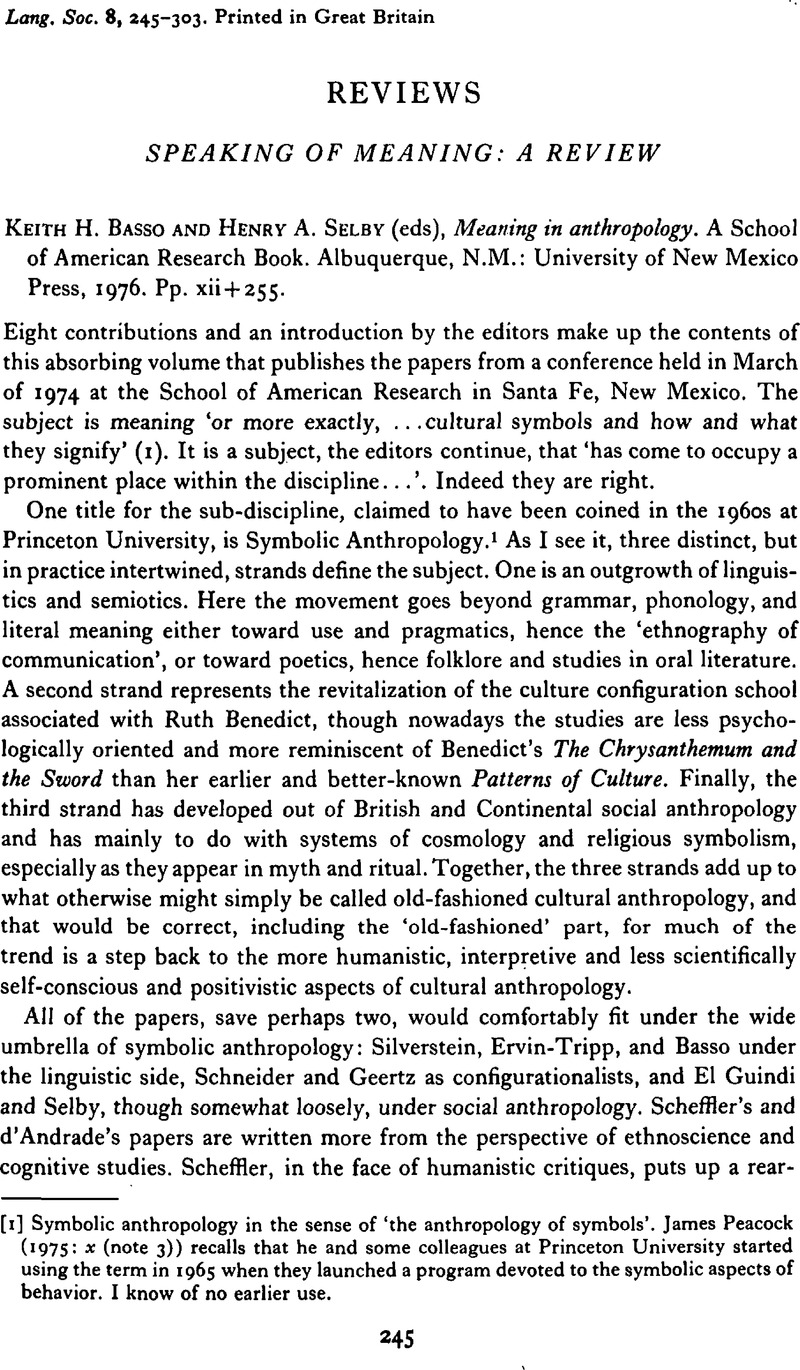No CrossRef data available.
Article contents
Speaking of Meaning: A Review - Keith H. Basso and Henry A. Selby (eds), Meaning in anthropology. A School of American Research Book. Albuquerque, N.M.: University of New Mexico Press, 1976. Pp. xii+255.
Published online by Cambridge University Press: 18 December 2008
Abstract
An abstract is not available for this content so a preview has been provided. Please use the Get access link above for information on how to access this content.

- Type
- Book Review
- Information
- Copyright
- Copyright © Cambridge University Press 1979
References
REFERENCES
Aristotle, (1954). Rhetoric. Translated by Roberts, W. Rhys. New York: Random House (The Modern Library).Google Scholar
Bloch, M. (1974). Symbols, song, dance, and features of articulation: Is religion an extreme form of traditional authority? Archives of European Sociology, 15. 55–81.CrossRefGoogle Scholar
Brown, R. & Gilman, A. (1960). The pronouns of power and solidarity. In Sebeok, T. A. (ed.), Style in language. Cambridge, Mass.: M.I.T. Press. 253–76.Google Scholar
Burke, K. (1966). Definition of man. In Language as symbolic action. Berkeley: University of California Press. 1–24.CrossRefGoogle Scholar
Casagrande, J. B. & Hale, K. H. (1967). Semantic relations in Papago folk-definitions. In Hymes, D. H. & Bittle, W. E. (eds), Studies in southwestern ethnolinguistics. The Hague: Mouton. 165–96.Google Scholar
Ervin-Tripp, S. (1976). Is Sybil there? The structure of American speech directives. LinS, 5(1). 25–66.Google Scholar
Fernandez, J. W. (1974). The mission of metaphor in expressive culture. Current Anthropology, 15(2). 119–46.CrossRefGoogle Scholar
Fernandez, J. W. (1977). The performance of ritual metaphors. In Sapir, J. David & Crocker, J. Christopher (eds), The social use of metaphor. Philadelphia: University of Pennsylvania Press.100–31.CrossRefGoogle Scholar
Geertz, C. (1966), Religion as a cultural system. In Banton, M. (ed.), Anthropological approaches to the study of religion. London: Tavistock Publications.Google Scholar
Goodenough, W. (1965). Yankee kinship terminology: A problem in componential analysis. American Anthropologist 67(5, Pt. 2). 259–87.CrossRefGoogle Scholar
Irvine, J. T. (to appear). Formality and informality in Communicative events. American Anthropologist.Google Scholar
Jakobson, R. (1957). Shifters, verbal categories, and the Russian verb. Cambridge, Mass.: Harvard University Russian Language Project.Google Scholar
Jakobson, R. (1960). Concluding statement: Linguistics and poetics. In Sebeok, T. A. (ed.), Style in language. Cambridge, Mass.: M.I.T. Press. 350–77.Google Scholar
Kroeber, A. L. & Kluckhohn, C. (1952). Culture: A critical review of concepts and definitions. (Papers of the Peabody Museum of American Archaeology and Ethnology, 47). Cambridge, Mass.: Harvard University Press.Google Scholar
Manes, J. I. (1976). The definition as a speech act. In Reich, P. (ed.), Second LACUS forum. Columbia, South Carolina: Hornbeam Press.Google Scholar
Manes, J. I. (1976a). Semantic relationships in American English folk definitions. (Unpublished Ph.D. dissertation). Philadelphia: University of Pennsylvanis.Google Scholar
Peirce, C. S. (1932). Collected papers of C. S. Peirce. Hartshorne, C. & Weiss, P. (eds). Cambridge, Mass.: Harvard University Press.Google Scholar
Ricoeur, P. (1977). The rule of metaphor. Toronto and Buffalo: University of Toronto Press.Google Scholar
Sapir, J. D. (1970). Kujaama: Symbolic separation among the Diola-Fogny. American Anthropologist, 72 (6). 1330–48.CrossRefGoogle Scholar
Sapir, J. D. (1977). The anatomy of metaphor. In Sapir, J. D. and Crocker, J. C. (eds), The social use of metaphor. Philadelphia: University of Pennsylvania Press. 3–32.CrossRefGoogle Scholar
Schneider, D. M. (1965). American kin terms and terms for kinsmen: A critique of Goodenough's componential analysis of Yankee kinship terminology. In Hammel, E. A. (ed.), Formal semantic analysis. American Anthropologist, 67(5, pt. 2). 288–308.Google Scholar
Schneider, D. M. (1968). American kinship: A cultural account. Englewood Cliffs, N.J.: Prentice Hall.Google Scholar
Schneider, D. M. (1972). What is kinship all about? In Reining, P. (ed.), Kinship studies in the Morgan centennial year. Washington, D.C.: Anthropological Society of Washington. 32–63.Google Scholar
Schneider, D. M. & Homans, G. (1955). Kinship terminology and the American kinship system. American Anthropologist, 57(6). 1194–208.CrossRefGoogle Scholar
Sperber, D. (1974). Le symbolisme en général. Paris: Hermann. (Collection Savoir). (English translation: Rethinking synbolism. Cambridge University Press, 1975.)Google Scholar
Weinreich, U. (1967). Lexicographic definition in descriptive semantics. In Householder, F. W. & Saporta, S. (eds), Problems in lexicography. Bloomington: Indiana University Press (originally published in 1962 as Part IV, IJAL, 28(2)).Google Scholar




